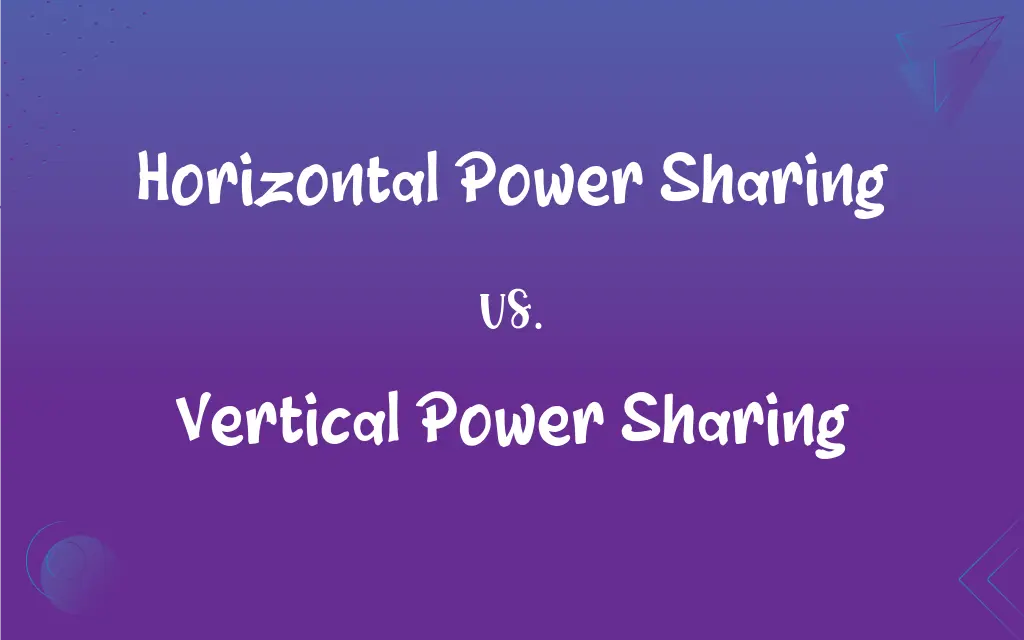Horizontal Power Sharing vs. Vertical Power Sharing: What's the Difference?
Edited by Aimie Carlson || By Janet White || Published on March 6, 2024
Horizontal power sharing is the distribution of power among different organs of government at the same level, while vertical power sharing involves power division among different levels of government.

Key Differences
Horizontal power sharing refers to the distribution of governmental power among different organs or branches at the same level, such as the executive, legislature, and judiciary. This form of power sharing is designed to ensure checks and balances, preventing any single branch from becoming too powerful. Vertical power sharing, on the other hand, pertains to the distribution of power across different levels of government, such as central, state, and local authorities. It is characterized by delegation or decentralization of powers to lower levels of government.
In horizontal power sharing, each branch has its distinct functions and powers but can check and balance the other branches. For instance, the legislative branch makes laws, the executive implements these laws, and the judiciary interprets them. In vertical power sharing, power is not just at the central level; it's shared with state and local governments, which have their autonomous powers. These different levels of government can make decisions independently within their jurisdiction.
Horizontal power sharing is crucial for democratic governance as it prevents the concentration of power and promotes accountability among various government branches. Each branch monitors the others, ensuring that democratic principles are upheld. Vertical power sharing, conversely, brings government closer to the people by decentralizing authority. It allows for more localized decision-making, often leading to more efficient and responsive governance.
In horizontal power sharing, coordination among branches is essential for effective governance, as each branch needs to work in harmony with the others despite their independence. This can sometimes lead to conflicts but is essential for a balance of power. Vertical power sharing requires effective collaboration between different levels of government to ensure coherence in policies and avoid overlap or conflict of jurisdiction.
Horizontal power sharing is seen in systems like the presidential or parliamentary forms of government, where separate branches have distinct roles. Vertical power sharing is exemplified in federal systems where national and regional governments have defined areas of authority. Both forms of power sharing are integral to democratic systems, ensuring power is not centralized and that citizens have representation at different levels.
ADVERTISEMENT
Comparison Chart
Level of Government
Involves organs of government at the same level.
Involves different levels of government.
Purpose
Ensures checks and balances among branches.
Decentralizes power for local governance.
Examples of Branches/Levels
Executive, Legislature, Judiciary.
Central, State, Local authorities.
Key Benefit
Prevents concentration of power in one branch.
Brings governance closer to the people.
Democratic Principle Emphasized
Balance of power and accountability.
Representation and responsiveness at various levels.
ADVERTISEMENT
Horizontal Power Sharing and Vertical Power Sharing Definitions
Horizontal Power Sharing
The allocation of equal powers to different organs of the government to prevent abuse of power.
Horizontal power sharing allows the judiciary to interpret laws without executive interference.
Vertical Power Sharing
A system where power is decentralized from the central government to regional and local authorities.
Vertical power sharing enables states to have their educational policies distinct from the central government.
Horizontal Power Sharing
The separation of powers within the government to enhance democratic governance.
Horizontal power sharing is evident in the independent functioning of the legislative branch.
Vertical Power Sharing
The distribution of power among different levels of government like central, state, and local.
Vertical power sharing allows local governments to make decisions tailored to their communities.
Horizontal Power Sharing
The division of powers among different branches of government at the same level.
Horizontal power sharing ensures that the judiciary can check the powers of the executive.
Vertical Power Sharing
The division of administrative duties among central, state, and local governments.
Vertical power sharing in federal countries involves state governments handling their law enforcement.
Horizontal Power Sharing
A governance model where power is distributed among various branches to ensure checks and balances.
Horizontal power sharing helps maintain a balance of power between the government's different branches.
Vertical Power Sharing
The allocation of governmental responsibilities across various levels to enhance local governance.
Through vertical power sharing, municipalities can manage local infrastructure projects.
Horizontal Power Sharing
A system where branches of government like the executive, legislature, and judiciary have separate powers.
In horizontal power sharing, the legislature is responsible for creating laws, independent of the executive.
Vertical Power Sharing
A governance structure where higher and lower levels of government share powers.
Vertical power sharing allows for state governments to legislate on matters not reserved for the central government.
FAQs
Can horizontal power sharing lead to conflicts?
Yes, conflicts can arise due to the independence of branches, but it's essential for balance.
What is vertical power sharing?
It's the distribution of power among various levels of government, such as central, state, and local.
How does horizontal power sharing enhance democracy?
By ensuring checks and balances among government branches, preventing power concentration.
What is a key benefit of vertical power sharing?
It brings governance closer to the people, allowing for localized decision-making.
What is horizontal power sharing?
It's the division of power among different branches of government at the same level.
Does vertical power sharing improve responsiveness?
Yes, it often leads to more efficient and responsive governance at the local level.
Is horizontal power sharing important in a parliamentary system?
Yes, it's crucial for maintaining checks and balances.
Can vertical power sharing lead to overlapping jurisdictions?
Sometimes, which is why clear demarcation of powers is important.
Are the judiciary, executive, and legislature part of horizontal power sharing?
Yes, these are the typical branches involved in horizontal power sharing.
What levels of government are involved in vertical power sharing?
Central, state, and local governments.
How does horizontal power sharing affect accountability?
It increases accountability by dividing power among separate branches.
Does vertical power sharing mean less power for the central government?
Not necessarily less, but it involves sharing power with lower levels.
How does vertical power sharing impact local communities?
It often leads to more tailored and effective governance at the local level.
Does horizontal power sharing require a constitution?
Typically, yes, as it outlines the separation of powers.
How does vertical power sharing affect policy coherence?
It requires effective collaboration between different government levels for coherent policies.
Does horizontal power sharing exist in dictatorships?
Generally, no, as power tends to be centralized in dictatorships.
Are checks and balances a feature of horizontal power sharing?
Yes, they're a fundamental aspect of this system.
Can a country have both horizontal and vertical power sharing?
Yes, many democratic countries employ both systems.
Are state governments part of vertical power sharing?
Yes, they are a key level in this form of power sharing.
How does horizontal power sharing differ in presidential systems?
The separation of powers is more pronounced in presidential systems, with a clear distinction between executive and legislative branches.
About Author
Written by
Janet WhiteJanet White has been an esteemed writer and blogger for Difference Wiki. Holding a Master's degree in Science and Medical Journalism from the prestigious Boston University, she has consistently demonstrated her expertise and passion for her field. When she's not immersed in her work, Janet relishes her time exercising, delving into a good book, and cherishing moments with friends and family.
Edited by
Aimie CarlsonAimie Carlson, holding a master's degree in English literature, is a fervent English language enthusiast. She lends her writing talents to Difference Wiki, a prominent website that specializes in comparisons, offering readers insightful analyses that both captivate and inform.
































































